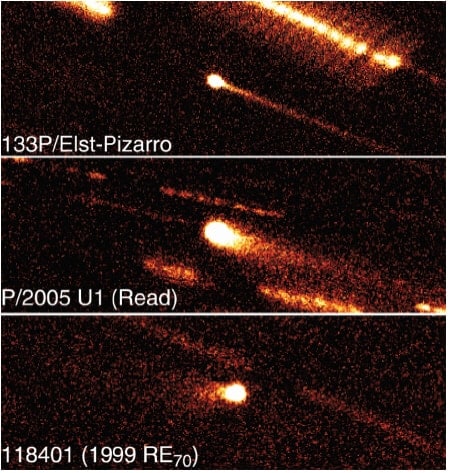A new class of comets that orbit within the main asteroid belt, between Mars and Jupiter, could have provided Earth with its present-day water say two astronomers in the US. Henry Hsieh and David Jewitt of the University of Hawaii have observed three objects in the asteroid belt which have the "dusty tails" characteristic of icy comets (Sciencexpress 1125150).

Comets are “undercooked leftovers” that remained after clouds of dust and gas condensed to form the Sun and planets some 4.5 billion years ago. Composed of ice, dust and gas, they are often known as “dirty snowballs”. As their orbits pass close to the Sun, the ice they contain sublimates, producing a characteristic tail of gas and dust. Previously, it was thought that comets were only formed in the cold outer reaches of the solar system — beyond Neptune in the Kuiper belt and Oort cloud — periodically approaching close to the Sun thanks to their elongated orbits.
Asteroids, on the other hand, have near-circular orbits and spend much more time close to the Sun and any ice once contained within them is thought to have evaporated long ago. However, a puzzling object called “133P/Elst-Pizarro” shows characteristics of both asteroids and comets. It was first classified as an asteroid because of its orbit, but in 1996, astronomers observed a dusty tail behind it — implying that the object was an ice-containing comet.
Over the last three years Hsieh and Jewitt have conducted a survey of the asteroid belt searching for similar objects. In November last year they observed a very faint dust tail from Asteroid 118401 using the 8m Gemini North telescope on Mauna Kea in Hawaii. Together with a third such object called P/2005 U1, observed independently in October 2005, this suggests the existence of a whole new class of comets orbiting entirely within the asteroid belt, which the two researchers have dubbed “Main-belt Comets”.
The Earth is thought to have formed as a hot, dry planet, with water delivered from elsewhere after it cooled. Possible candidates for this water are comets or asteroids but recent analyses have shown that the isotopic composition of comet water is significantly different from the ocean water found on Earth today. “Main-belt comets are a potential source of the Earth’s water,” says Hsieh. “However, more detailed study is needed before we can say anything definitive.”
The team now plans to characterize the new comets more fully and search for additional main-belt comets. Further in the future, spacecraft could even visit the comets and analyse the ice to determine whether these objects really did bring water to Earth.



